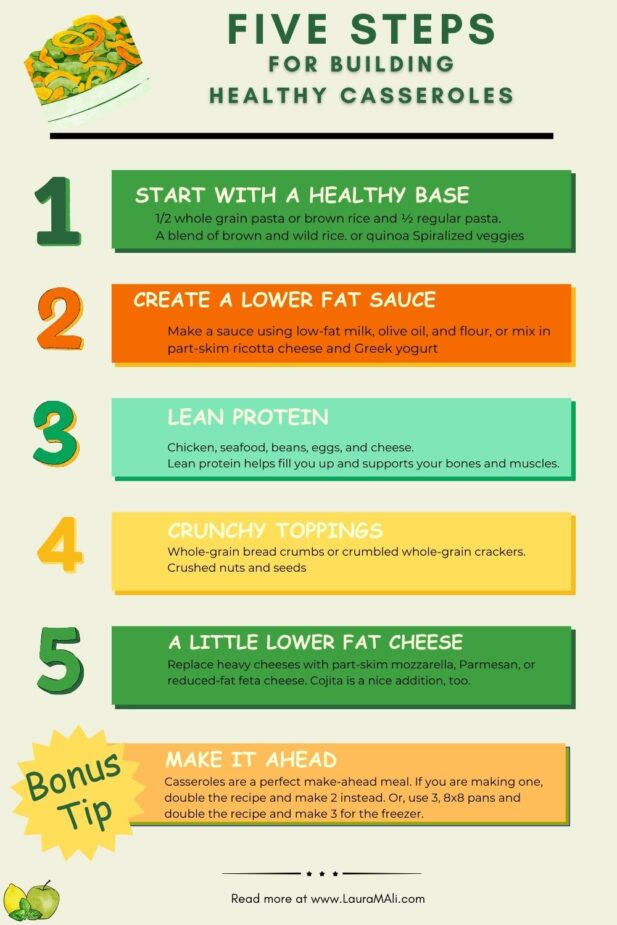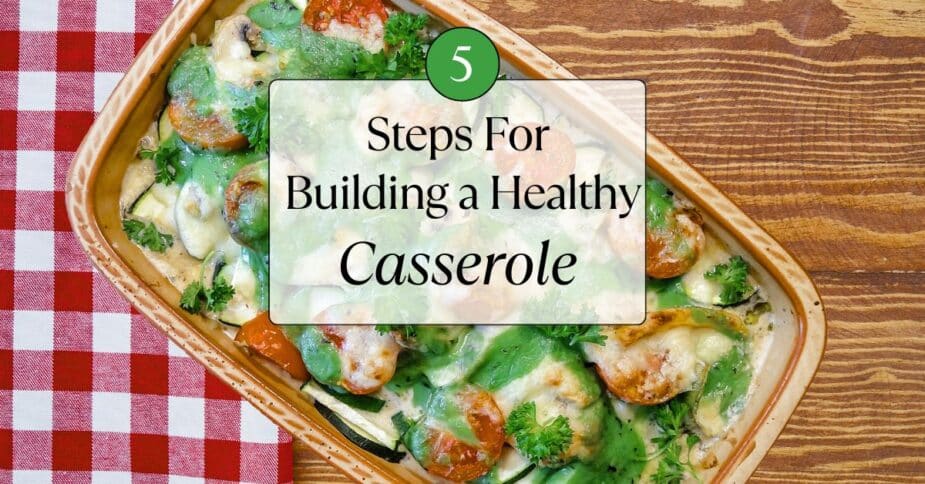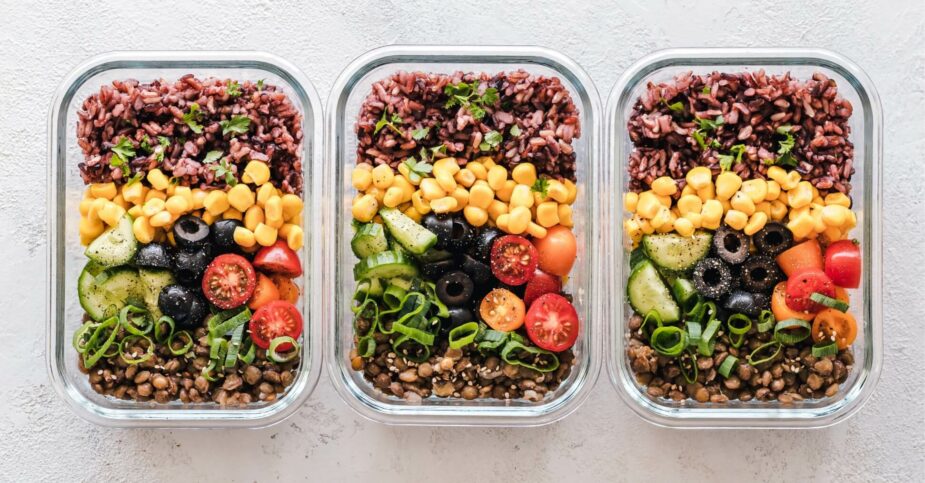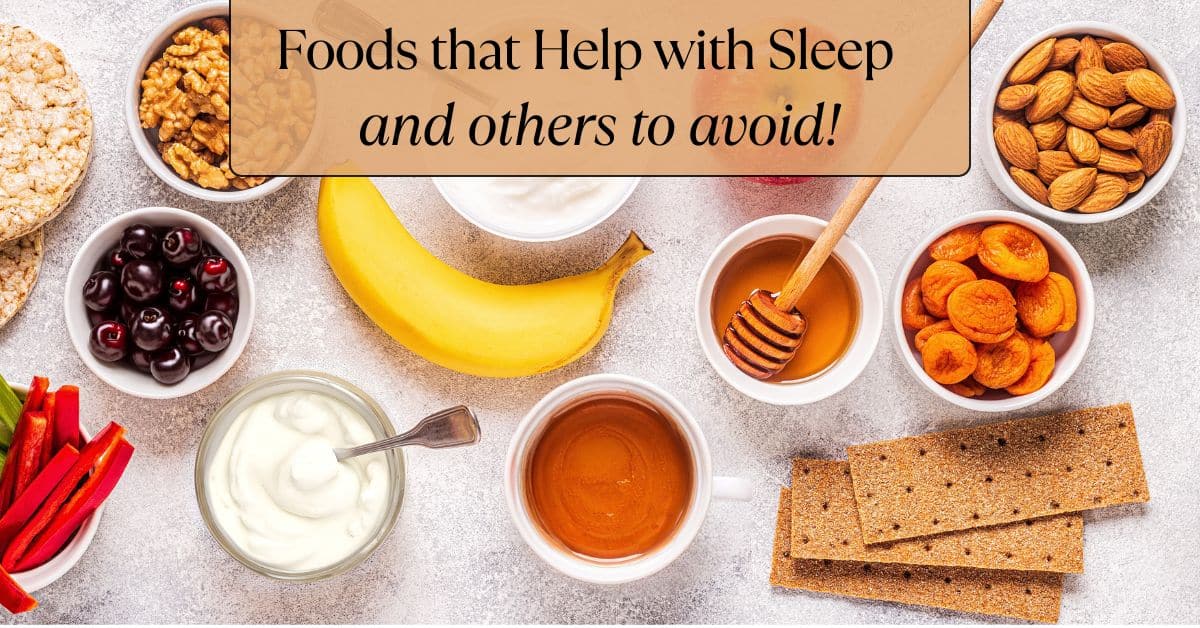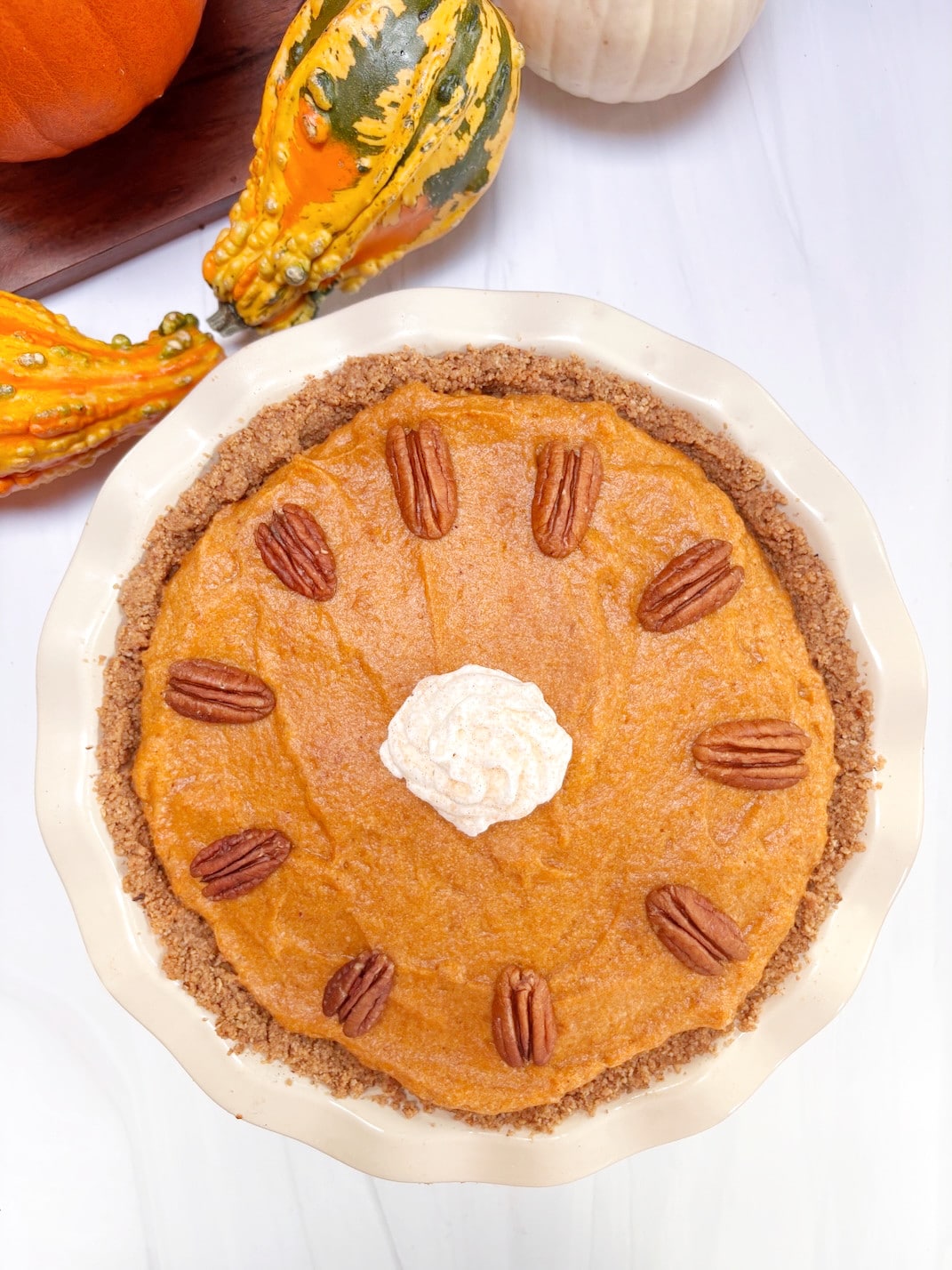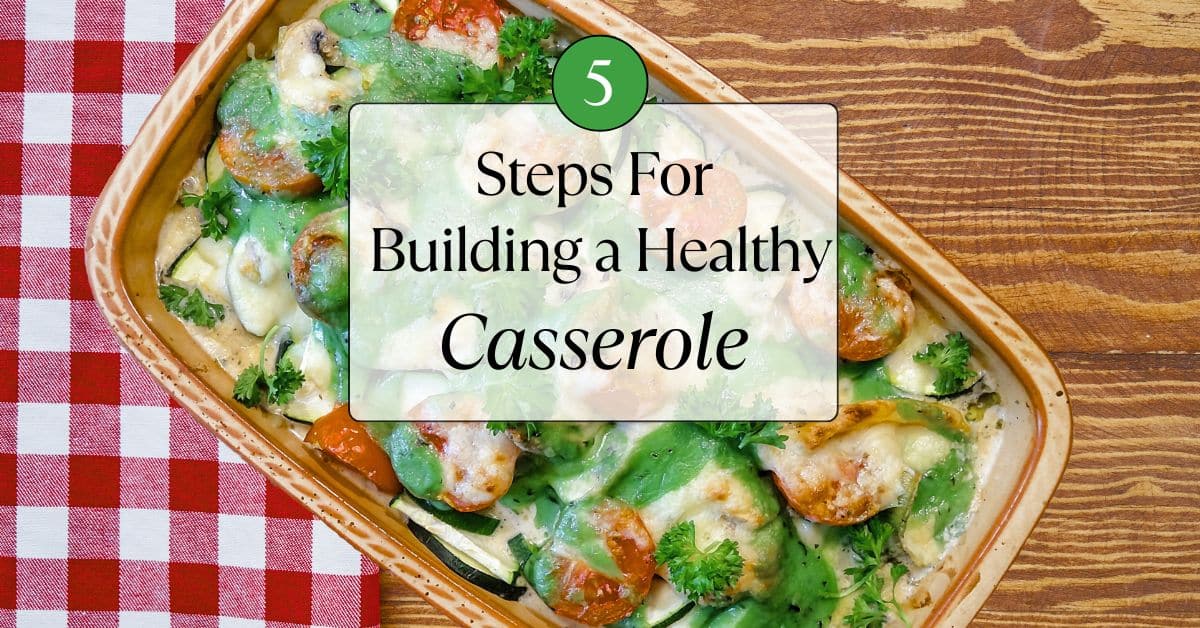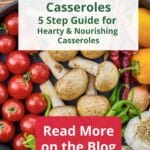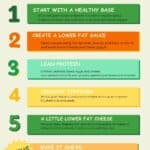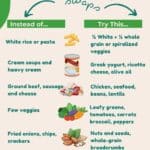There’s something so comforting about a warm, bubbly casserole fresh from the oven. But did you know this classic dish can also be a nutritional powerhouse that supports your health?
With a few smart ingredient swaps, you can create casseroles that not only satisfy your taste buds but also support heart health, boost brain function, and promote healthy aging.
Hi, I’m Laura, a Registered Dietitian, and I love casseroles because they are versatile, healthy, and great make-ahead meals. In this blog post, you’ll learn simple, delicious steps to master the art of healthy casseroles. Yes, you can enjoy cozy, comforting meals that nourish your body and keep you feeling vibrant for years to come.
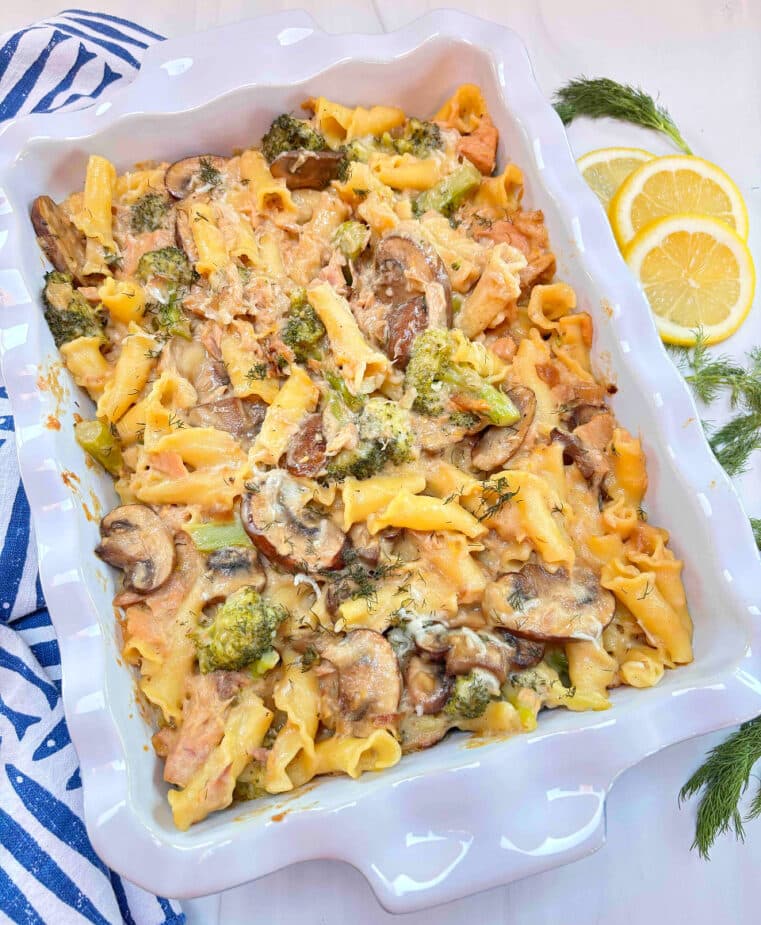
Table of Contents
The Power of a Healthy Casserole
What is a casserole? Typically, it is a one-pot meal that consists of a starchy base of pasta or rice and protein, including beef, sausage, chicken, and cheese. They are held together by a creamy or tomato sauce and baked in the oven, or sometimes slowly cooked on the stovetop or in a slow cooker.
That description doesn’t exactly create a picture of healthy eating for most people. But with a few careful ingredient selections, each of these one-pot dishes can be a nutritional superstar and an important part of a healthy diet and lifestyle.
By combining lean proteins, fiber-rich grains, colorful vegetables, and heart-healthy fats, you can create a variety of one-pot meals that not only taste amazing but also support your heart, brain, and overall vitality.
Heart Health
If you are focused on keeping your heart healthy or need to keep your cholesterol in check, there are several things you can do to make a casserole work for you.
- Swap out those cream sauces with a tomato or olive oil-based sauce to help support your heart.
- Add beans, lentils, mushrooms, or soy as alternatives to high-fat meat.
- Use whole grains, such as brown rice, quinoa, or whole-grain pasta, in place of refined carbohydrates for added fiber.
- Use a variety of herbs and spices in place of excess salt. They add flavor, and a bit of nutrition too.
All of these ideas can contribute to lowering cholesterol, supporting healthy blood pressure, and maintaining a strong cardiovascular system.
Brain Health
Adding to the principles for a heart-healthy casserole, there are a few other ingredient swaps that can help support your brain health as well.
- Fish can be swapped for higher-fat meats. Yes, a tuna noodle casserole is one option, but fish can easily replace your favorite meat, too. Seafood that contains omega-3 fatty acids is both heart and brain-healthy, so think about swapping seafood in place of higher-fat meats.
- Don’t forget about the veggies. Adding some hearty vegetables like leafy greens, carrots, broccoli, and mushrooms amps up the nutritional quality and adds a good dose of anti-inflammatory nutrients that help protect memory and support cognitive function.
Healthy Aging
Yes, casseroles can certainly help support healthy aging. Including lean proteins helps preserve our muscle mass and keeps us strong.
- Mixing in colorful vegetables can help reduce inflammation.
- Adding fiber-rich ingredients such as brown or wild rice, beans, lentils, and nuts supports digestion.
- Eggs, seafood, and mushrooms are natural sources of vitamin D. This “sunshine vitamin” helps support the immune system and works with calcium to support our bones.
- Herbs and spices have antioxidants and other nutrients that can also lower inflammation.
All of these ingredients are important for helping you stay active and vibrant as the years go by.
How to Build a Healthy Casserole
So that is why and how casseroles can help support your health goals. Now, let me show you how to do it so you can put it into practice and add more of these delicious meals to your repertoire.
Step 1 – Choose Your Base
Most casseroles start with a starchy base—pasta, rice, or sometimes tortillas. And yes, I know, carbohydrates often get a bad rap! But the truth is, they have a lot of nutrition too. Carbs are an important source of energy, and when chosen wisely, they can absolutely be part of a healthy casserole and a healthy diet.
Whole grains like brown rice, quinoa, barley, and whole-grain pasta bring fiber, B vitamins, iron, and antioxidants that support heart health, brain function, and digestion.
But that doesn’t mean refined grains are off-limits. Enriched white rice and regular pasta still provide valuable nutrients and even a few grams of fiber per serving.
And let’s be honest—sometimes you just crave the taste and texture of “the real thing.” Truth be told, I prefer regular pasta, and that is what I use most of the time. A serving still provides 2-3 grams of fiber, and that isn’t bad!
Healthy base ideas to try:
- Pasta or egg noodles (whole grain or regular)
- Brown or white rice
- Rice blends (white, brown, wild rice)
- Quinoa
- Corn tortillas
- Barley or farro
- A mix of pasta and vegetables

Did you know that pasta adds starch that helps thicken the sauce in your casserole without adding extra heavy cream and cheese? Save some of that pasta water to help thicken your sauce.
Step 2 – Add Lean Proteins
Lean proteins add bulk and flavor to your casseroles, and protein will help keep you feeling full and satisfied. Choose one or two of these to add to your casserole:
- Roasted Poultry: Chicken or turkey
- Sausage for flavor: But go with turkey or chicken sausage
- Seafood: Salmon, tuna, shrimp, or crab meat
- Vegetarian options: Soy crumbles, tofu, or vegetarian sausage
- Eggs: don’t forget about breakfast casseroles! They make great lunches and dinners too.
- Cheese: But stick with reduced-fat Cottage cheese or ricotta cheese
- Beans: Kidney, black beans, cannellini beans, and lentils
Step 3 – Pack in the Produce
Just as we recommend that half of your plate should be vegetables, the same applies to a casserole. They add bulk and nutrition, so go and fill it up!
Some of my favorite veggies to add to casseroles:
- Leafy greens: baby spinach, kale, or Swiss chard.
- Other Vegetables: broccoli and cauliflower, shredded brussels sprouts, corn, peas, green beans, sliced peppers, artichoke hearts, carrots, onions, zucchini, eggplant, and mushrooms.
- Tomatoes: Diced tomatoes, roasted grape tomatoes, stewed tomatoes, tomato sauce
- Squash: Zucchini, summer squash, butternut squash, pumpkin.
- Potatoes: Sweet potatoes, red potatoes, russet potatoes.
Step 4 – Focus on Adding Flavor
While pasta and protein are the main components of a casserole, what really makes them shine is the flavor you add. There are many ways to add flavor without loading up on fat and salt.
- Start with an aromatic base of onions and garlic
- Add dried herbs and spices
- In place of a heavy cream sauce or canned cream soup, make a sauce from a blend of butter and oil with flour and broth. This is called a roux, and it gives your casserole a nice creamy consistency, but with less saturated fat and sodium.
- Cut back or eliminate the heavy cream, butter, and cheese; Use Greek yogurt, part-skim cheese, and healthy oil like olive oil in their place.
Step 5 – Smart Toppings
Skip the potato chips or fried onion rings and choose some more nutrient-dense options or combinations. Top your creation with:
- A blend of bread crumbs and nuts for some healthy fats.
- Crushed whole wheat crackers or unsweetened whole grain cereal like Fiber One.
- Parmesan or Romano cheese mixed with breadcrumbs for some added flavor, but a bit of a lighter topping.
- Slivered almonds, crushed pistachios, pumpkin seeds, or chopped peanuts can add a flavorful crunch.
- Chopped fresh herbs or microgreens garnish when it comes out of the oven.
Bonus Step – Make It Ahead
Casseoles are the perfect “make-ahead” meal, and they aren’t just for busy working families either. They are great meal solutions, no matter what stage of life you are in.
A casserole typically makes 4 – 6, or more servings, so they are perfect for leftovers when you are a 1 or 2-person household. They are great for entertaining, too.
I usually have at least a couple of casseroles in the freezer for those nights when I either don’t feel like cooking or am busy and need a quick dinner. I can just pop them in the oven while I take care of other things.
(Note – you can also have a ready-to-go meal in case a friend is sick or injured or has had a baby. Plus, if you’re sick, these are a simple way to nourish yourself, even if you have no energy to cook.)
A couple of tips for prepping your casserole components ahead of time to save time:
- Cut and prep some of your vegetables ahead of time or buy precut veggies.
- Mix the topping ahead of time and store it in an air-tight container.
- Use leftover rotisserie chicken or precook your protein and keep it in freezer-safe bags to use later. Frozen chicken or meat will last for up to 3 months when wrapped tightly.
- Canned salmon or tuna are easy seafood options that are already cooked, so you can mix them in without needing to cook them ahead.
- Make use of canned and frozen veggies. These are just as healthy as fresh. Most are packed within hours of harvesting and have just as much nutrition as their fresh counterparts. Buy the low-sodium or no-added salt versions so you can season it to your taste and your needs.
- Batch-cook the pasta, rice, or other grains. Store it in the refrigerator in an airtight sealable bag or container for a few days. You may need to toss it with olive oil to keep it from sticking.
- Make two casseroles while you are making one. Divide it into the portion sizes and amounts you’ll need and freeze them for easy meals later.
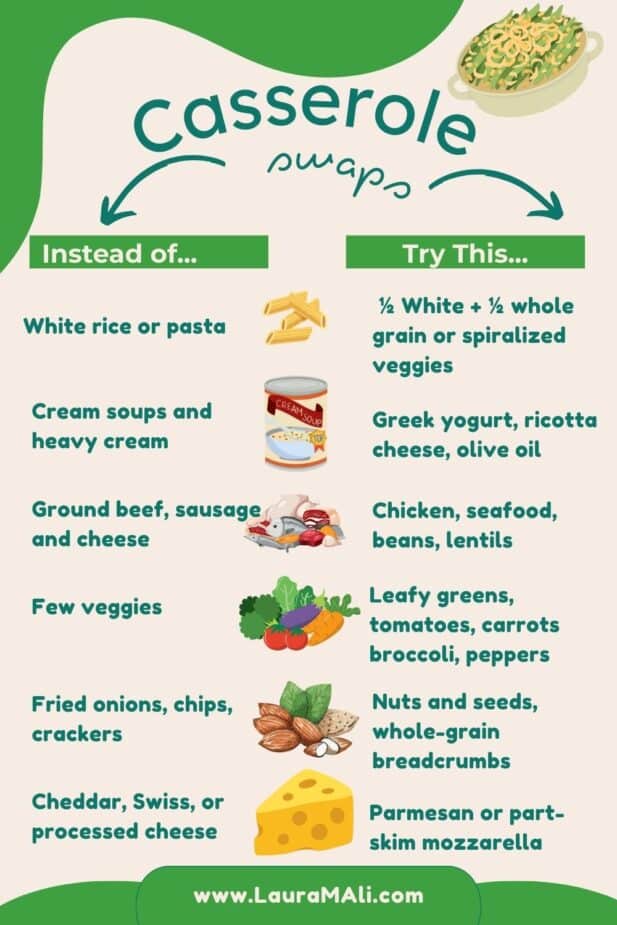
How to Cook, Freeze, and Thaw Casseroles
Having a freezer stocked with frozen meals is a great time-saving tip. Here are a few tips for the best ways to freeze them and how to prepare them when you are ready.
Stock up on smaller-sized casserole pans. An 8×8 pan works well for 2 – 4 people, and for a regular recipe that fits a 9×13 pan, double it, and it will fit into 3 8×8 square pans. (A friend of mine discovered this when she was meal prepping before her maternity leave.)
Cool before freezing. Let your casserole cool completely before covering and freezing to avoid ice crystals and freezer burn.
Wrap well. Use a double layer—plastic wrap directly on the casserole surface, then aluminum foil or a freezer-safe lid—to lock in freshness.
Label and date. Add the name of the casserole and the date you froze it so you don’t lose track. Most casseroles keep well for up to 3 months if wrapped tightly.
Freeze before baking (when possible). Assemble your casserole and freeze it unbaked. This helps keep texture and flavor fresher when you’re ready to cook.
Thaw safely. Move the casserole from the freezer to the refrigerator 24 hours before baking. This ensures even cooking.
Bake from frozen (if you’re in a hurry). Add 30–45 minutes to the baking time and cover with foil so the top doesn’t overbrown before the inside heats through.
And a tip for baking – place the casserole on a sheet pan, then place it in the oven, especially if you are using a foil pan. The pan catches any spills and makes it much easier to remove from the oven without spilling.
Check doneness with a thermometer. Aim for an internal temperature of 165°F to be sure it’s heated safely. Use an instant-read thermometer and place it in the center of the casserole to get an accurate reading. (The edges will be hotter than the center.)
Par-bake for crispier results. If your casserole has a crunchy topping, bake it uncovered for 10–15 minutes at the end to restore texture.
Portion smartly. Freeze single servings or servings for two in small containers for easy grab-and-reheat meals.
Personalizing Your Casserole
The wonderful things about casseroles are that they are easy to modify, you can mix and match ingredients, and you can make them for a crowd, or just one or two people. Here are some of my favorite tricks for amping up the nutritional value and making them my own.
Modifying Your Favorite Casserole Recipes
Want to give your favorite casserole a healthy upgrade? Small tweaks can make a big difference without sacrificing comfort or flavor.
- Cut back on the starch: Use less pasta or rice and bulk up with vegetables, beans, or lentils to lower calories and boost fiber.
- Go half-and-half: Mix regular pasta or rice with spiralized zucchini, cauliflower rice, or other veggies. This adds nutrients while still giving you the starch you need for creaminess and structure.
- Lighten up the sauce: Swap heavy cream for Greek yogurt, part-skim ricotta, or a simple béchamel made with olive oil and milk.
- Be smart with cheese: Use sharp or aged varieties (like Parmesan or cheddar) so a little goes a long way, or try part-skim mozzarella for melting.
- Boost the lean protein: Add beans, lentils, or shredded chicken for staying power and muscle support.
- Season freely: Herbs, spices, citrus, and garlic add flavor without the need for excess salt or fat.
- Top with extra crunch: Instead of heavy breadcrumbs or fried onions, try whole-grain breadcrumbs, crushed nuts, or seeds.
3 Sample Healthy Casserole Combinations
- Sundried Tomato Orzo with Chicken – This is a stovetop casserole. It’s made entirely in one pan and simmers on the stove. The sundried tomatoes and mushrooms add a rich, hearty flavor, and spinach gives it an extra boost.
- Healthy Salmon Casserole with Brown and Wild Rice: salmon, green beans, carrots, brown and wild rice, in a light lemon tarragon sauce.
- Creamy Lemon Dill Tuna Pasta Bake – A twist on the classic tuna noodle casserole. Filled with broccoli and mushrooms, the tuna packed in olive oil blends perfectly with the lemon and dill seasoned sauce.
Final Thoughts
Casseroles make dinnertime easy and delicious. And while at first glance they may conjure images of heart-clogging meals, they can and should be a part of your healthy meal routine.
By choosing your ingredients carefully and making some key ingredient swaps, you can have a variety of ready-to-go and make-ahead meals that support your health and nutrition.
Yes, they are comfort food and comfort food that, with a few simple ingredient swaps, can help support your heart, brain, and goal of aging gracefully and healthfully.
Love these ideas and want to save them for later? Pin this so you can come back later!
